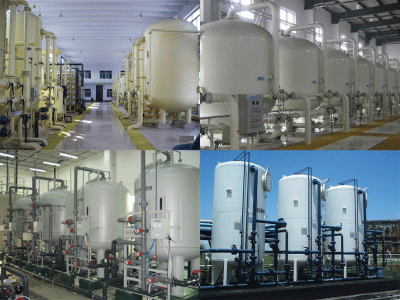The utility model relates to a filter device of a tank body, whose shell is generally stainless steel or FRP, and the inner part is filled with activated carbon, which is used to filter free substances, microorganisms and some heavy metal ions in water, and can effectively reduce the color of water.
Activated carbon filter is a kind of commonly used water treatment equipment. As the pretreatment of water treatment desalination system, it can absorb residual chlorine which can not be removed in the former filtration. It can effectively guarantee the service life of the latter equipment, improve the water quality of the effluent and prevent pollution, especially in the free residual chlorine of the latter reverse osmosis membrane and ion exchange resin. Toxic pollution. At the same time, it also adsorbs pollutants such as small molecular organic matter leaked from the previous stage, which has obvious adsorption and removal effects on odors, colloids, pigments and heavy metal ions in water, and also has the effect of reducing COD. The SDI value of RO inlet can be further reduced, and SDI<5 and TOC<2.0ppm can be guaranteed.
Application scope
It is widely used in food, medicine, electronics, chemical industry, industrial wastewater and other industries.
Main points of installation:
1, it can meet the requirements of the hydraulic system for filtering accuracy, and can block certain impurities from entering the system.
2, the filter element should have sufficient strength and will not be damaged due to pressure.
3, the ability to flow through is large and the pressure loss is small.
4. Easy to clean and replace.
Product features
1, high efficiency: 24 hours continuous work without shut-down backwash.
2, low running cost: no backwash pump with high lift and large flow.
3. Low maintenance cost: it has no rotating parts except quartz sand filter material during operation, low failure rate and low maintenance cost.
4. Low one-time investment: no single coagulation pool, clarification pool and other facilities, no backwash pump and electric, pneumatic valves and other equipment, small amount of engineering, one-time investment is saved.
5. Small head loss: single filter material, clean and timely filter material, small head loss, total head loss less than 0.5m.
6. The requirement of influent water quality is relaxed: it can endure 150 mg/L SS influent water quality for a long time and 300 mg/L SS impact for a short time, but the effluent water quality remains unchanged.
7. The effluent quality is stable and the filtration effect is good. The filter material is clean and timely, which ensures high quality and stable effluent effect and no cyclical fluctuation of water quality.
8. Easy to rebuild and expand: The unit operation mode adopted can flexibly increase or delete the number of filters according to the change of water volume, which is easy to rebuild and expand.
9. Small area and beautiful appearance: It integrates the traditional three-stage reclaimed water treatment process, saving about 70-80% of the land, and has a more beautiful and compact appearance.
influence factor
The main factors affecting the adsorption of activated carbon are:
Properties of activated carbon adsorbent
The larger the surface area is, the stronger the adsorption capacity will be. Activated carbon is a non-polar molecule, which is easy to adsorb non-polar or low polar adsorbates. The size of activated carbon adsorbent particles, the structure and distribution of fine pore and surface chemical properties also have a great impact on the adsorption.
Properties of adsorbents
Depending on its solubility, surface free energy, polarity, size and unsaturation of adsorbate molecules, concentration of adsorbate, etc.
PH value of wastewater
Activated carbon generally has a higher adsorption rate in acidic solutions than in alkaline solutions.
The PH value will affect the state and solubility of adsorbate in water, thus affecting the adsorption effect.











